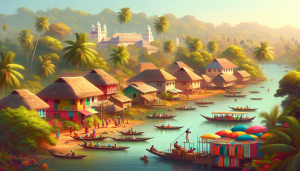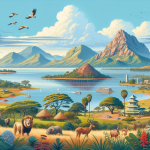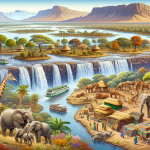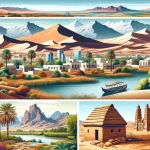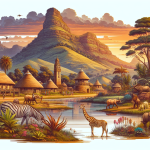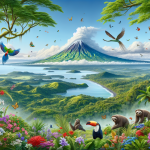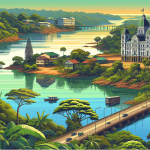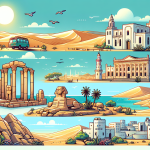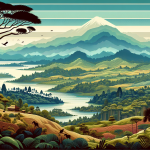Discovering Gambia: The Hidden Gem of West Africa
The Gambia, often simply referred to as Gambia, is a small yet enchanting country nestled on the West African coast. It is entirely surrounded by Senegal except for its western coastline, which borders the Atlantic Ocean. Despite its modest size, Gambia is brimming with cultural richness, vibrant traditions, and natural beauty. Known as “The Smiling Coast of Africa,” Gambia offers visitors a unique blend of history, wildlife, and stunning landscapes. Whether you’re an adventurer seeking the thrill of exploring new terrains or a history buff eager to delve into the cultural tapestry of a country that played a pivotal role in the transatlantic slave trade, Gambia has something for everyone. In this comprehensive guide, we’ll explore the many facets of Gambia, from its bustling capital city of Banjul to the serene banks of the River Gambia, ensuring you have all the information you need for an unforgettable journey.
Exploring Banjul: The Heart of Gambia
Banjul serves as the capital city of Gambia and is a small yet lively hub of activity and culture. Located on St. Mary’s Island at the mouth of the River Gambia, Banjul may not boast the sprawling urban landscapes of other African capitals, but it more than makes up for it with its historical significance and charming ambiance. The city’s architecture is a fascinating blend of colonial-era structures and modern buildings, reflecting its rich history and evolving present. One of the most iconic landmarks in Banjul is Arch 22, a towering monument that commemorates the country’s 1994 coup d’état. Visitors can climb to the top for panoramic views of the city and the surrounding landscape.
For those interested in history, the National Museum in Banjul offers an insightful glimpse into Gambia’s past. The museum houses a diverse collection of artifacts, from traditional musical instruments to colonial-era relics. Another must-visit site is the Albert Market, a bustling marketplace where you can find everything from local crafts and textiles to fresh produce. The market is a sensory overload in the best possible way, with vibrant colors, enticing aromas, and the lively chatter of vendors and shoppers alike.
The River Gambia: Lifeline of the Country
The River Gambia is the country’s most significant geographical feature, stretching over 700 miles from the Fouta Djallon highlands in Guinea to the Atlantic Ocean. The river is a vital lifeline for the country, supporting agriculture, fishing, and transportation. For tourists, the River Gambia offers a myriad of opportunities for exploration and adventure. One of the most popular activities is taking a boat trip along the river, which allows you to experience the stunning natural beauty of the region firsthand.
Birdwatchers will find the River Gambia particularly appealing, as it is home to an astonishing variety of avian species. The river’s banks are lined with lush mangrove forests, which provide a habitat for birds such as the African Fish Eagle, Goliath Heron, and the colorful Malachite Kingfisher. If you’re lucky, you might also spot some of the river’s resident wildlife, including hippos, crocodiles, and monkeys.
The Rich Cultural Heritage of Gambia
Traditional Music and Dance
Gambia’s cultural heritage is deeply rooted in its traditional music and dance. The country is known for its vibrant musical scene, which features a variety of genres ranging from traditional folk music to modern Afrobeat. One of the most iconic instruments in Gambian music is the kora, a 21-string lute-bridge-harp that is played by griots, or traditional storytellers. The kora’s melodious tunes are often accompanied by drumming and dancing, creating a captivating performance that reflects the country’s rich cultural tapestry.
Festivals and Celebrations
Gambia is also home to a number of festivals and celebrations that showcase its cultural diversity. One of the most popular events is the annual Roots Homecoming Festival, which celebrates the country’s connection to the African diaspora. The festival features a variety of activities, including traditional music and dance performances, historical tours, and cultural workshops. Another notable event is the Kanilai International Cultural Festival, which brings together artists and performers from across the region to celebrate the rich cultural heritage of West Africa.
The Enchanting Wildlife of Gambia
National Parks and Reserves
Gambia’s natural beauty is not limited to its river and coastline; the country is also home to a number of national parks and wildlife reserves that offer a sanctuary for a diverse array of flora and fauna. One of the most popular parks is the Kiang West National Park, which covers an area of over 115 square miles and is home to a variety of wildlife, including monkeys, antelopes, and over 300 species of birds.
Another must-visit destination for nature lovers is the Abuko Nature Reserve, which is located just a short drive from Banjul. The reserve is one of the oldest protected areas in Gambia and offers visitors the chance to see a variety of wildlife, including crocodiles, monitor lizards, and a wide range of bird species. The reserve also features several walking trails, making it an ideal destination for hiking and birdwatching.
Gambia’s Stunning Beaches
No visit to Gambia would be complete without spending some time on its beautiful beaches. The country’s Atlantic coastline is dotted with pristine sandy shores, offering the perfect setting for relaxation and water-based activities. One of the most popular beaches is Kololi Beach, which is known for its lively atmosphere and vibrant nightlife. The beach is lined with a variety of bars, restaurants, and hotels, making it a popular destination for tourists and locals alike.
For those seeking a more tranquil beach experience, the secluded shores of Sanyang Beach offer a peaceful retreat. The beach is less crowded than Kololi and is known for its stunning sunsets and serene ambiance. Visitors can enjoy a leisurely swim in the warm waters, take a stroll along the sandy shores, or simply relax and soak up the sun.
Conclusion
Gambia may be one of the smallest countries in Africa, but it is undoubtedly one of the most captivating. From its bustling capital city of Banjul to the serene banks of the River Gambia, the country offers a diverse range of experiences for travelers. Whether you’re interested in exploring the rich cultural heritage, embarking on a wildlife adventure, or simply relaxing on the stunning beaches, Gambia has something to offer everyone. So why wait? Start planning your trip to “The Smiling Coast of Africa” and discover the hidden gem of West Africa.
Travel Tips for Gambia
Best Time to Visit
The best time to visit Gambia is during the dry season, which runs from November to May. During this time, the weather is warm and sunny, making it ideal for outdoor activities and exploration. The rainy season, which lasts from June to October, can bring heavy rainfall and humidity, which may limit some activities.
Getting Around
While Gambia is a small country, getting around can be a bit challenging due to the limited public transportation options. Taxis are widely available and are a convenient way to get around, especially in urban areas. For longer distances, bush taxis and minibuses are commonly used, although they can be crowded and less comfortable.
Health and Safety
Before traveling to Gambia, it’s important to take certain health precautions. Make sure to get the necessary vaccinations, including those for yellow fever, typhoid, and hepatitis A. It’s also advisable to take malaria prophylaxis, as the disease is prevalent in the region. When it comes to safety, Gambia is generally considered a safe destination for tourists, but it’s always important to stay vigilant and take common-sense precautions, such as avoiding isolated areas at night and keeping an eye on your belongings.
Currency and Language
The official currency of Gambia is the Gambian dalasi (GMD). While credit cards are accepted in some hotels and restaurants, it’s a good idea to carry cash for smaller purchases and when traveling to more remote areas. English is the official language of Gambia, making it relatively easy for English-speaking travelers to communicate. However, you may also hear a variety of local languages, including Wolof, Mandinka, and Fula.
Top Attractions in Gambia
Kachikally Crocodile Pool
Located in the heart of Bakau, the Kachikally Crocodile Pool is one of Gambia’s most unique attractions. The pool is home to a number of Nile crocodiles, which are considered sacred by the local community. Visitors can get up close to these fascinating creatures and even have the opportunity to touch them under the supervision of a guide. The site also features a small museum that provides insight into the cultural and historical significance of the pool.
James Island (Kunta Kinteh Island)
For those interested in history, a visit to James Island, also known as Kunta Kinteh Island, is a must. This UNESCO World Heritage Site is located in the River Gambia and played a significant role in the transatlantic slave trade. The island is named after Kunta Kinteh, the main character in Alex Haley’s novel “Roots,” which tells the story of his ancestor’s enslavement and journey to America. Visitors can explore the ruins of the fort and learn about the island’s history through informative displays and guided tours.
Makasutu Culture Forest
For a truly immersive experience, a visit to the Makasutu Culture Forest is highly recommended. This private reserve is located along the banks of a tributary of the River Gambia and offers a unique blend of nature and culture. Visitors can take guided tours through the forest, where they can spot wildlife such as baboons, monitor lizards, and a variety of bird species. The reserve also offers cultural experiences, including traditional dance performances, craft workshops, and cooking demonstrations.
Gambia’s Culinary Delights
Traditional Gambian Cuisine
Gambian cuisine is a delightful blend of flavors and influences, reflecting the country’s diverse cultural heritage. One of the most popular dishes is domoda, a rich peanut stew made with meat or fish and served with rice. Another favorite is benachin, also known as Jollof rice, a flavorful one-pot dish made with rice, vegetables, and either fish or meat.
Seafood lovers will also find plenty to enjoy in Gambia, with fresh fish and shellfish featuring prominently in the local cuisine. Grilled fish, known as yassa, is a popular dish, often marinated in a tangy sauce made with lemon, onions, and spices. For a sweet treat, be sure to try tapalapa, a traditional Gambian bread that is often enjoyed with a variety of toppings, including butter, jam, or honey.
Dining in Gambia
While Gambia offers a variety of traditional dishes, you’ll also find a range of international cuisine in the country’s restaurants and hotels. In the larger towns and tourist areas, you can find restaurants serving everything from Italian and Indian to Chinese and Lebanese cuisine. Many of the beachside bars and restaurants also offer a selection of fresh seafood dishes, often accompanied by live music and entertainment.
Responsible Tourism in Gambia
As with any travel destination, it’s important to practice responsible tourism when visiting Gambia. This means being mindful of the local culture and environment, and making an effort to support the local economy. When shopping for souvenirs, consider purchasing handmade crafts and products from local artisans. This not only supports the local economy but also ensures that you take home a unique and authentic piece of Gambian culture.
When exploring the natural beauty of Gambia, be sure to follow the principles of Leave No Trace. This means taking care to minimize your impact on the environment, such as by staying on designated trails, disposing of waste properly, and respecting wildlife and their habitats. By practicing responsible tourism, you can help ensure that Gambia remains a beautiful and welcoming destination for future generations.
Conclusion
Gambia is a destination that offers a wealth of experiences for travelers, from its rich cultural heritage and vibrant music scene to its stunning natural beauty and diverse wildlife. Whether you’re exploring the bustling streets of Banjul, cruising along the River Gambia, or relaxing on a pristine beach, you’re sure to be captivated by the charm and warmth of this West African gem. So why not start planning your adventure to Gambia today? With its friendly people, fascinating history, and breathtaking landscapes, Gambia is a destination that promises to leave a lasting impression.
External Link
For more information on planning your trip to Gambia, visit the [official Gambia tourism website](http://www.visitthegambia.gm/).
